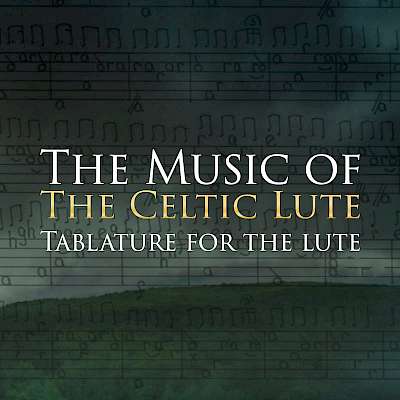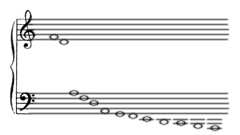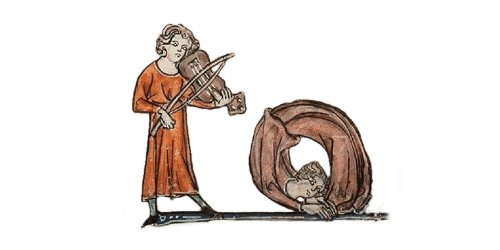 Here are my arrangements of Scottish and Irish tunes recorded on The Celtic Lute CD. They are handwritten in lute tablature for 13-course Baroque lute in d minor tuning:
Here are my arrangements of Scottish and Irish tunes recorded on The Celtic Lute CD. They are handwritten in lute tablature for 13-course Baroque lute in d minor tuning:

At times, you’ll need to adjust the sharps or flats of the low bass strings according to the key of the piece. This is noted in the upper left corner of the page whenever a sharp or flat is needed in the bass.
Since the 1970s I’ve been an enthusiastic fan of Celtic bands and musicians. I’ve enjoyed playing Scottish music on the lute since the 1980’s, and there’s a repertory of hundreds of Scottish tunes for the lute from the 17th century. Many of those tunes did not originate as lute music. Rather, lute players some 400 years ago must have enjoyed particular Scottish melodies well enough to make arrangements for the lute. So, following in the footsteps of these musicians from centuries ago, I’ve made arrangements of my favorite Scottish and Irish tunes that were never arranged for the lute back in the day. Many of the tunes recorded on The Celtic Lute are difficult to date with any precision, but most seem to come from the 17th and 18th centuries. I’ve played them on a 13-course Baroque lute in d minor tuning since this was the lute of the 18th century, and the music fits this lute and this tuning very well.
Scottish Music
“The Battle of Harlaw” is one of the most touching melodies on The Celtic Lute. The title refers to a Medieval battle in Scotland fought on July 24, 1411. The battle, between Highland clans (led by Donald of Islay, Lord of the Isles) and Lowland clans (led by Alexander Stewart, Earl of Mar), left 1500 Scotsmen dead. The battle was sometimes known as “Red Harlaw” because of the extreme bloodshed. The melody dates from the early 17th century, during the reign of King James I of England (aka King James VI of Scotland). The earliest version comes down to us in an English manuscript from about 1624-5. In modern performances, this haunting tune is often played with a simple drone or with stark and spare harmony. In my lute solo arrangement I’ve chosen to support the melody with a more elaborate harmony which, to my ears, brings out a more intense and nuanced hearing of the melody. I’ve also decorated the melody freely when the A section returns midway through the piece.
Many of the Scottish tunes on The Celtic Lute were originally published by Niel and Nathaniel Gow. Niel Gow was born in 1727 in Inver, about 60 miles northwest of Edinburgh. He taught himself the violin at an early age and became one of the most important violinists and composers in Scotland. His son, Nathaniel Gow, was born in 1763 and was also a talented composer and performer. The Gows published single sheets and folios of Scottish tunes for violin from 1784 to 1822. They contain strathspeys, reels, jigs, slip jigs, airs, hornpipes, marches, waltzes and other miscellaneous tunes. These various publications were collected into one big book of nearly 600 tunes: The Gow Collection of Scottish Dance Music, compiled and edited by Richard Carlin, Oak Publications 1986. All of the tunes are published as single-line melodies without any accompaniment. Many of them remind me of the melodies in the Balcarres Lute Book (c. 1700), and occasionally one finds a tune in common between these sources. I used the settings in the Balcarres Lute Book as my model for arranging these 18th century Scottish fiddle tunes for the 13-course Baroque lute. Tunes arranged from The Gow Collection include “The Flaggon,” “The Stool of Repentance,” “The Lone Vale,” “Flee Over the Water,” “Hoop Her and Gird Her” and “If I Had a Bonny Lass.”
Irish Music
The anonymous (traditional) Irish dances on The Celtic Lute are arranged from O’Neill’s Music of Ireland, a collection of more than 1000 fiddle tunes. It includes jigs, slip jigs, reels and hornpipes among others. All the tunes in O’Neill’s are presented as unaccompanied single-line melodies for the violin. I’ve made these arrangements by adding bass notes and ornaments where it seems fitting and natural for the Baroque lute. The tunes from O’Neill’s Music of Ireland include “Banish Misfortune,” “Pipe on the Hob,” “Cliffs of Moher,” “The Monaghan Jig,” “Kid on the Mountain,” and “The Butterfly.”
Francis O’Neill (1848-1936) was an enthusiastic amateur musician who emigrated from Ireland to America as a teenager. He settled in Chicago, became a policeman and eventually became Chief of Police. As a musician he was a flutist, fiddler and piper. He collected traditional Irish tunes from performers, printed sources, wax cylinders and by remembering tunes from his childhood. O’Neill’s Music of Ireland was published in 1903. But who knows how many years these Irish tunes had been passed down through the oral tradition, generation after generation, before they finally found their way into print?
I’m grateful that O’Neill collected and published these pieces; however it is impossible to convey the fluidity of music in the oral tradition when one decides to capture it in notation. Here is an example of the difficulty, from the introduction to the 1976 edition of O’Neill’s Music of Ireland, written by Miles Krassen: “Perhaps the essence of the problem is illustrated by a humorous account of a meeting between fiddler John McFadden and the renowned piper Patsy Touhey: It seems that on this particular occasion Touhey wanted to learn a tune from McFadden. He had McFadden play it for him several times and then tried his own hand at it. Of course McFadden had to play it again, pointing out several “errors.” This happened a number of times until Tohey finally gave up, for McFadden was playing the tune a little differently each time through!”
Music of Turlough O’Carolan
I’m especially pleased, and a bit surprised, at how naturally the harp pieces of Turlough O’Carolan fit the Baroque lute. The source I used for his music is the thorough, colorful and well-researched book by Donal O’Sullivan, CAROLAN, The Life, Times and Music of an Irish Harper Ossian Publications, Ltd. 2001. In this book, O’Carolan’s music is notated as single-line melodies without accompaniment. Donal O’Sullivan writes:
“Carolan’s compositions were taught by himself, by his friend and fellow harper Charles MacCabe, and doubtless by others of his contemporaries; and they were extensively played by harpers, violinists and flautists who came afterwards. Authoritative copies of them were not, so far as we know, committed to writing in the lifetime of the composer. They thus passed into the general stream of Irish traditional music, though in the majority of cases Carolan continued to be recognized as their author.
In these circumstances, where two or more independent versions are found it is sometimes not easy to say which is the authentic tune. In general, I have preferred simpler versions to those which give a large amount of ornamentation; for Carolan was primarily a melodist, and the ornamentation was almost certainly added at a later date by professional violinists and others.
In many of the printed sources the melodies are provided with an accompaniment in the bass clef. These accompaniments are all omitted in this edition. They are not, of course, by Carolan, but were devised by the various editors for the instruments they had in mind - harp, violin, oboe, piano and so on.”
On The Celtic Lute, rather than using accompaniments from old printed sources that are not by Turlough O’Carolan, I have created new lute arrangements that support O’Carolan’s melodies with bass lines and harmonies that seem natural and which bring out the character of his compositions.

